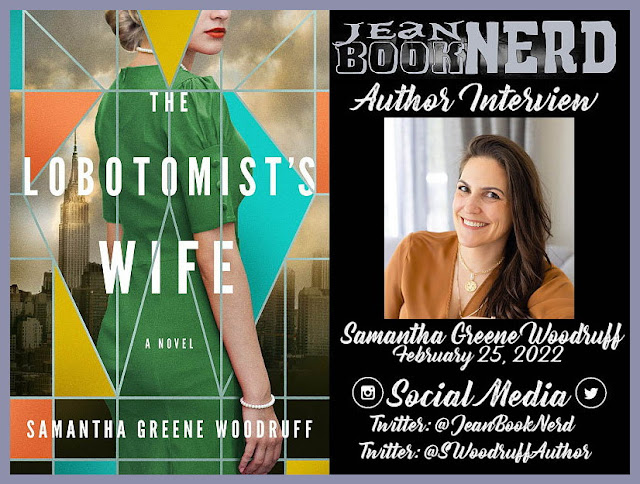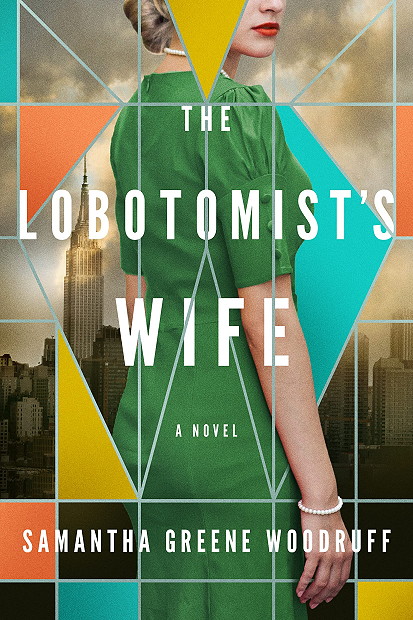Photo Content from Samantha Greene Woodruff
After leaving corporate life, she pursued her varied passions, teaching yoga, cooking, and taking classes at the Writing Institute at Sarah Lawrence College. It was here that she combined her multifaceted background with her wild imagination and passion for history, reading, and writing. The Lobotomist’s Wife is her first novel, and she is already at work on her next historical fiction book. Sam lives in southern Connecticut with her husband, two children, and two dogs.

Greatest thing you learned in school.
Hmmm…the most interesting thing I learned in school was about the Velvet Revolution in Eastern Europe in the 1980s. I was fascinated by the idea that philosophers and poets could become political leaders and overturn systemic oppression. The most usable thing I learned in school was the difference between a stock and a bond, which I didn’t know until I was 29 and in business school, because I studied history. The most valuable thing I learned in school was time management and prioritization. I still remember the first semester of my freshman year of college when I was so overwhelmed because I thought I had to read every word of every assignment, which was nearly impossible. Part of learning is how to do what you need to do to get the work done well, without killing yourself entirely.
What was your favorite book as a child?
The first three that pop to mind are A Wrinkle in Time, The Westing Game and The Boxcar Children.
Why is storytelling so important for all of us?
Storytelling enables us to comment on our world, to dream about other worlds, to be entertained, to be challenged and to simply escape.
What was the single worst distraction that kept you from writing this book?
My kids, who were 8 and 10 at the time. Love them dearly, but it isn’t easy to get lost in another world when you are needed by someone every 15 minutes.
What are some of your current and future projects that you can share with us?
I am currently in the early stages of research for a new novel, also historical fiction but not at all medical. The new story is about the financial roller coaster of the 1920s and focuses on a twin brother and sister.
In your newest book; THE LOBOTOMIST'S WIFE, can you tell my Book Nerd community a little about it.
The Lobotomist’s Wife is a story about two women whose lives intersect around their relationships with a fictionalized version of the man who invented the ice pick lobotomy. The protagonist, Ruth, is an American heiress and an independent woman running a mental hospital in the 1930s, a time when that was highly unusual; her own family trauma has led her to dedicate her life to helping the mentally ill. She ultimately marries the man who pioneered lobotomy in the U.S. and, in essence, becomes his accomplice in popularizing the procedure. She is entirely fictional, by the way. The second woman is a housewife in the early 1950s who is suffering from postpartum depression and becomes a patient of the lobotomist’s and, possibly, his next victim.
What do you hope for readers to be thinking when they read your novel?
While this is novel undoubtedly explores the history of mental health, and a dark chapter in its history at that, I really see this as a story about the struggle to fit in, in a world where who we are doesn’t always conform to society’s norms. My hope is that readers realize this and think “hey, maybe I should be a little kinder to myself.”
If you could introduce one of your characters to any character from another book, who would it be and why?
Maybe Robert Apter to Dr. Frankenstein? So he could learn that sometimes “progress” in medicine isn’t actually progress.
TEN QUOTES FROM THE LOBOTOMIST'S WIFE:
- “Sometimes, the best you can do for someone is to stand beside them, appreciate their strength, and acknowledge their pain.” p. 290
- “Forgive me for saying so, but in my experience, life doesn’t often unfold as it ‘should.’ Instead, we need to learn to make the best of what it is. Even in the hard times.” p. 217
- “‘Did you know that hydrangeas change color depending on the acidity of the soil they’re planted in?’ Ruth paused. ‘I’ve always loved the idea–that you can change the environment to change the flower itself.’” p. 217
- “Helen didn’t see the woman who was actually sitting in front of her; instead, when forced to spend time with her daughter, Helen simply pretended Ruth was the person Helen wanted her to be.” p. 45
- “Ruth’s heart warmed even as it pounded fiercely in her chest. She was acutely aware that her hospital stood on one side of the line between being mildly progressive and entirely radical. Although terrified to make the leap, she couldn’t wait to jump across to the other side.” p. 90
- “‘I know you’re tired, but that’s motherhood.’” p. 114
- “‘You are a great woman, Ruth Emeraldine. You will find your way. We will find your way.’” p. 283
- “Margaret felt like an hourglass that had been flipped over moments before the last grains of sand drained to the bottom. How could Frank say this now?” p. 270
- “Even as the words crossed her lips, she felt the respect she had worked for her entire life falling away.” p. 250
- “‘No. It’s all right. It must be a very frightening way to feel.” Ruth paused, looking off at the horizon, and then turned back to Margaret, gently taking hold of her hands. “I wonder, though, what would happen if you stopped expecting yourself to be so perfect?’” p. 216
The right. Definitely. Also the right side of the bed.
What decade during the last century would you have chosen to be a teenager?
1960s – the music, the clothes, the sense of limitlessness and freedom.
Best date you've ever had?
Seeing the band Oasis in concert with my husband (that dates me for sure!). Our first dance at our wedding was to Wonderwall.
What event in your life would make a good movie?
Everything I can think of is too embarrassing to someone else…
Last Halloween Costume you wore and when?
I think it was Wonder Woman a few years ago when my son was into super heroes.
First Heartbreak?
Josh Friendly, 9th grade boyfriend. He was a senior!
Favorite things to do alone?
Yoga, sing, read, watch TV.
Meet the Characters
RUTH EMERALDINE
Ruth is a passionate, charismatic American heiress dedicated to caring for her patients at New York’s top mental hospital, Emeraldine. Driven by her tender-hearted work to right the wrong of her brother’s suicide after the end of WWII and appease her dismissive family members, Ruth’s values are put into question when she is forced to choose between her loyalty to a man she loves and her duty to protect her patients before it is too late.
MARGARET BAXTER
After marrying her high school sweetheart after WWII, Margaret trades in her dreams of becoming a nurse for the job of wife and mother in suburban New Rochelle. Following the birth of her third child, when undiagnosed postpartum depression exacerbates her restlessness and prohibits her from finding joy in her quotidian life, she becomes a patient at Emeraldine. Robert claims that lobotomy is her best chance of a cure; will her budding friendship with Ruth help her find an alternate path to happiness?
ROBERT APTER
Robert is a medical genius dedicated to finding a better way to treat mental illness using an ice-pick-like instrument to perform lobotomies–and a romantic who piques Ruth’s interest along the way. But, over time, his desperation to create a lasting legacy in medicine blinds him to his invention. How far will his fanatic behavior go in name of a miracle cure? Robert’s character is inspired by the work of Walter Freeman II, an American neuroscientist responsible for introducing the U.S. population to prefrontal lobotomy.
SUPPORTING CHARACTERS
EDWARD WILKINSON
Edward is a young neurosurgeon and Robert’s partner in the early development of lobotomy. He is a mild-mannered, loyal sidekick to Robert, helping build a lasting medical legacy while remaining unsure of his own character. Though when the truth of their medical invention is revealed, Edward is met with the difficult choice to stand up to his mentor, support Ruth, and own his sexual orientation.
FRANK BAXTER
Margaret’s husband is a modern man, by 1950s standards. While Frank still expects the basics – food on the table, a drink in hand as he comes home -- he is patient, kind and consistently supportive of Maggie. He genuinely wants her to be happy by any means, even if his doubts about lobotomy linger.
BERNARD EMERALDINE
Bernard is Ruth’s domineering father, whose only soft spot was for his now-deceased son Harry. Ruth has spent her whole life trying to be enough for her father, and, only after experiencing loss, does she realize she even came close.
SUSIE DAVENPORT
Susie is Ruth’s fearless best friend from Mount Holyoke. She comes from a Boston brahmin family and spends her time advocating for communities experiencing poverty. She lives with her girlfriend in Greenwich Village.
ELAINE SMITH
Elaine is Margaret’s friend from her days as a nurse cadet. She is an independent-minded Black woman from Maggie’s old neighborhood in the Bronx who encourages her to come back to nursing, a job that brought her intense satisfaction.
An enthralling historical novel of a compassionate and relentless woman, a cutting-edge breakthrough in psychiatry, and a nightmare in the making.
Since her brother took his life after WWI, Ruth Emeraldine has had one goal: to help those suffering from mental illness. Then she falls in love with charismatic Robert Apter—a brilliant doctor championing a radical new treatment, the lobotomy. Ruth believes in it as a miracle treatment and in Robert as its genius pioneer. But as her husband spirals into deluded megalomania, Ruth can’t ignore her growing suspicions. Robert is operating on patients recklessly, often with horrific results. And a vulnerable young mother, Margaret Baxter, is poised to be his next victim.
Margaret can barely get out of bed, let alone care for her infant. When Dr. Apter diagnoses her with the baby blues and proposes a lobotomy, she believes the procedure is her only hope. Only Ruth can save her—and scores of others—from the harrowing consequences of Robert’s ambitions.
Inspired by a shocking chapter in medical history, The Lobotomist’s Wife is a galvanizing novel of a woman fighting against the most grievous odds, of ego, and of the best intentions gone horribly awry.
jbnpastinterviews
















16
ReplyDeleteI was 16.
ReplyDelete17
ReplyDeleteNOYB
ReplyDeleteI don't recall.
ReplyDelete